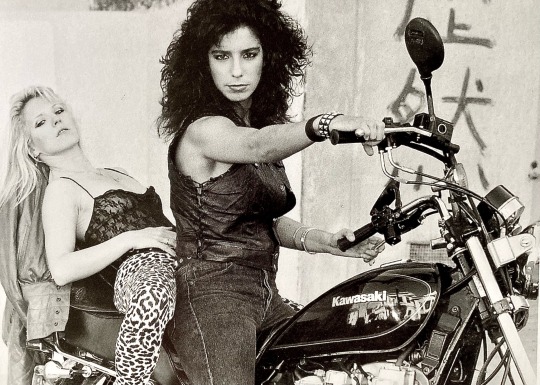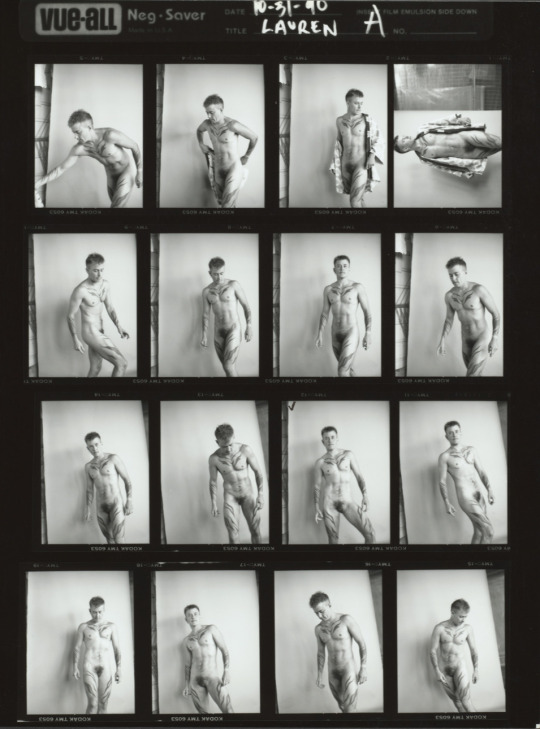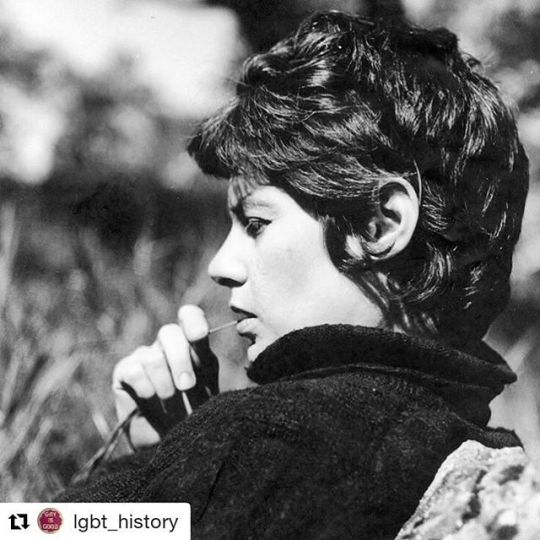#photographer: honey lee cottrell
Text

"Cassie and Laurie" by Honey Lee Cottrell, 1985.
source: Nothing But the Girl: The Blatant Lesbian Image, edited by Susie Bright and Jill Posener
#lesbian literature#lesbian#dyke#thatbutcharchivist#archived#lesbian books#lesbian photography#year: 1998#publisher: freedom editions#nothing but the girl#author: susie bright#author: jill posener#photographer: honey lee cottrell#lesbian art#butch lesbian#butch#butch dyke#femme lesbian#femme#femme dyke#butch4femme#femme4butch#motorcycle#dykes on bikes
961 notes
·
View notes
Text


Honey Lee Cottrell, Loren Rex Cameron (1990).
Also a photographer, Cameron's work depicts the lives, portraits, and nudes of transsexual men and women. Primarily focusing on physical aspects of his own transition and that of other trans men, his photographs are known for their dynamism and illusion of movement.
3K notes
·
View notes
Text


photography by Honey Lee Cottrell
"Facing the onslaught of AIDS in the 1980s, California activists produced public health campaigns that encouraged safer sexual practices by making them look sexy. Erotic images distinguished California activists’ public health campaigns for safer sex. In that spirit, these photographs by Honey Lee Cottrell eroticize and bring an artist’s eye to using latex dental dams and gloves. Lesbian AIDS activists suggested using these medical supplies to create barriers between mouths, genitals, and hands as methods for safer sex." - source
#honey lee cottrell#lesbian archive#lesbian art#lesbian herstory#lesbian history#lgbt history#lesbian#dyke#on our backs
5 notes
·
View notes
Photo

Honey Lee Cottrell (deceased)
Gender: Female
Sexuality: Lesbian
DOB: 16 January 1946
RIP: 21 September 2015
Ethnicity: White
Occupation: Photographer, activist, director
#Honey Lee Cottrell#lesbian history#lgbt#lgbtq#lgbt history#female#lesbian#1946#rip#historical#white#photographer#activist#director#popular#popular post
126 notes
·
View notes
Photo






I thought it would be cool to find some queer history colouring pages, and it turns out there are several books’ worth of them! A couple of these are just one-offs from non-queer sources, but for those from books, I definitely encourage you to support some queer artists and invest in this very wholesome and soothing hobby. If you can’t do that, there are also some you can download for free!
Top to bottom, left to right:
Moroccan lesbian Cherifa, Tangier’s first female grain seller, from Butch Lesbians of the ‘20s, ‘30s, and ‘40s Coloring Book (sample pages available here)
Mexican artist Frida Kahlo (source)
Zuni lhamana craftsperson and ambassador We’wha from LBGTQ History Coloring Book (sample pages available here)
Bisexual American First Lady and activist Eleanor Roosevelt (source)
Irish writer Oscar Wilde from The Queer Heroes Colouring Book (source)
Lesbian photographer and filmmaker Honey Lee Cottrell from Butch Lesbians of the ‘50s, ‘60s, and ‘70s Coloring Book (sample pages available here)
Please tag us if you colour any of these. I’d love to see them!
103 notes
·
View notes
Photo



Women participating in Ovulars workshops at Rootworks womyn’s land
In the 1970s, communities of feminist, separatist, and mostly lesbian women began to build their own utopia across the United States. Giving up their former lives and the comforts of home, they headed to private rural land where they could live free from the shackles of the patriarchy. They called them “Womyn’s lands”—unlike other communes of the “Back to the Land” era, many of the women were emphatic about the gender rules: no hetereosexual people and no men.
It was in this closed single-sex environment that a series of photography workshops called the Ovulars emerged, taking place each summer in the early 1980s. They were held at Rootworks, the Womyn’s land that photographer and poet Ruth Mountaingrove and her partner Jean founded in Oregon. Later, makeshift darkrooms cropped up in other Womyn’s lands. The artists who taught at the Ovulars included Joan E. Biren, or JEB; Tee Corinne, and Honey Lee Cottrell. The workshop’s name was a feminist repossession of “seminars,” and they spawned a prolific archive; one that was fundamental to the identity of the women and the ideology of the Womyn’s lands—a declaration of their right to exist.
(source)
204 notes
·
View notes
Photo

#Repost @lgbt_history with @repostapp ・・・ Honey Lee Cottrell (January 16, 1946 – September 21, 2015), c. 1976. Photo by Tee Corinne, copyright @lesbianherstoryarchives. Honey Lee Cottrell, who was born seventy-one years ago today, was a photographer, filmmaker, eroticist, and butch lesbian whose work “revolutionized the female nude, validated women’s right to pleasure, and opened possibilities for women to see themselves and their desires in new ways.” In the mid-1970s, Cottrell began exhibiting her photography in San Francisco, and she became well-known for her portraits of friends and lovers. She collaborated with Tee Corinne and the two became lovers, as described in the 1976 documentary “We Are Ourselves.” In 1978, Cottrell presented her groundbreaking lesbian imagery in the book “I Am My Lover.” That same year, she was a co-founder of the San Francisco Lesbian and Gay History Project. Cottrell is perhaps best-known as one of the “core four,” along with Debi Sundahl, Nan Kinney, and Susie Bright, whose contributions to the lesbian sex magazine, “On Our Backs,” gave the publication its style and success. Cottrell, who was a contributing photographer to “On Our Backs” for seven years, also was responsible for many of the publication’s defining features. For example, it was Cottrell who suggested the “Bulldagger of the Month” centerfold, which, she later explained, was intended to “stand this ‘Playboy’ centerfold idea on its head from, I would say, a feminist perspective…What would I do if I was a centerfold and how can I reflect back our values as lesbians?” Cottrell’s work confronted and destroyed “the faux lesbian images of straight male porn. Instead we were given the real bodies of real lesbians, bodies we could almost touch, they were so vivid and so real and so us. So lesbian.” Honey Lee Cottrell died of pancreatic cancer on September 21, 2015; she was sixty-nine. #lgbthistory #HavePrideInHistory #HoneyLeeCottrell
0 notes
Text

“The lesbian gaze meant that there was a contemplation, a restraint, a sincerity and a warrior-quality. This lesbian look was compelling. While your heterosexual woman model might compel the rest of the world to look at her, a lesbian was addressing you.”
Honey Lee Cottrell was a contributing photographer for the lesbian erotic magazine On Our Backs for the majority of its publications. Her partner during this time was Susie Bright, the magazine's co-founder and editor. Cottrell also photographed lesbian S/M communities, and her depictions of kink and leatherdykes would appear in books published by SAMOIS, such as the 1981 Coming to Power. SAMOIS was a lesbian-feminist BDSM organization, existing from the late 70s into early 80s. It was a source of extreme controversy among major feminist groups, namely those that were opposed to S/M as a form of ritualized, sexual violence against women. Conflicts between SAMOIS and such groups sparked the earliest of the so-called battles in the Feminist Sex Wars.
The above image of Cottrell - in an open shirt and briefs, with her gaze directed right at the viewer and exposed body posed casually, dynamically - appeared in a 1984 issue of On Our Backs. Bulldagger of the Season was a project created with the intention of satirizing Playboy's popular piece Playmate of the Month.
Cottrell knew how to wield the power of the lesbian gaze, and commands a confident, butch eroticism. Her sexual competence is signalled throughout; her unreserved stare is an unambiguous addressal of the dyke looking at, and perhaps lusting over, her and the suggestion of sex she presents. Her boldness and assurance in her own female masculinity as a self-identified bulldagger is the tantalizing counterpart to a femme lover's pursuit. Indeed, when compared to the vapid passivity of the Playboy image, Cottrell's unmistakeable, active sexuality defines the blatant lesbian erotic gaze.
#if tumblr shortens the post please read the commentary#honey lee cottrell#butch lesbian#butch dyke#on our backs#bulldagger#lesbian photography#lesbianism
279 notes
·
View notes